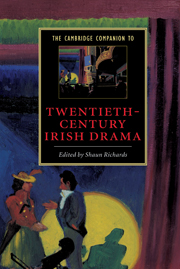Book contents
- Frontmatter
- 1 Plays of (ever) changing Ireland
- 2 Late nineteenth-century Irish theatre: before the Abbey – and beyond
- 3 The ideology of the Abbey Theatre
- 4 The theatre of William Butler Yeats
- 5 Lady Gregory’s Abbey Theatre drama: Ireland real and ideal
- 6 J. M. Synge, ‘national’ drama and the post-Protestant imagination
- 7 On the siting of doors and windows: aesthetics, ideology and Irish stage design
- 8 Oscar Wilde and the politics of style
- 9 George Bernard Shaw and Ireland
- 10 Sean O’Casey’s Dublin Trilogy: disillusionment to delusion
- 11 Ireland’s ‘exiled’ women playwrights: Teresa Deevy and Marina Carr
- 12 Samuel Beckett and the countertradition
- 13 Brian Friel’s sense of place
- 14 The Field Day Theatre Company
- 15 Tom Murphy and the children of loss
- 16 Reconstructing history in the Irish history play
- 17 The Abbey Theatre and the Irish state
- 18 Staging contemporary Ireland
- 19 The Revival revised
- Guide to further reading
- Index
- Series List
12 - Samuel Beckett and the countertradition
Published online by Cambridge University Press: 28 May 2006
- Frontmatter
- 1 Plays of (ever) changing Ireland
- 2 Late nineteenth-century Irish theatre: before the Abbey – and beyond
- 3 The ideology of the Abbey Theatre
- 4 The theatre of William Butler Yeats
- 5 Lady Gregory’s Abbey Theatre drama: Ireland real and ideal
- 6 J. M. Synge, ‘national’ drama and the post-Protestant imagination
- 7 On the siting of doors and windows: aesthetics, ideology and Irish stage design
- 8 Oscar Wilde and the politics of style
- 9 George Bernard Shaw and Ireland
- 10 Sean O’Casey’s Dublin Trilogy: disillusionment to delusion
- 11 Ireland’s ‘exiled’ women playwrights: Teresa Deevy and Marina Carr
- 12 Samuel Beckett and the countertradition
- 13 Brian Friel’s sense of place
- 14 The Field Day Theatre Company
- 15 Tom Murphy and the children of loss
- 16 Reconstructing history in the Irish history play
- 17 The Abbey Theatre and the Irish state
- 18 Staging contemporary Ireland
- 19 The Revival revised
- Guide to further reading
- Index
- Series List
Summary
At the very end of the twentieth century, more precisely on 22 December 1999, the Mayor of Paris, Jean Tiberi, unveiled a plaque renaming a portion of l'avenue René Coty in the fourteenth arrondissement of Paris in honour of Samuel Beckett. The plaque reads:
Allée Samuel Beckett
Foxrock 1906 – Paris 1989
Ecrivain Irlandais
Prix Nobel de Littérature
'Samuel Beckett Alley' seems especially appropriate for the writer whose most memorable characters were tramps lacking middle-class values and fond of off-colour jokes. But it is even more appropriate that at the end of the century the French government would recognize and certify that a writer living in France and often writing in French could nevertheless remain an Irish writer. The Irish government essentially did the same much earlier by establishing the Samuel Beckett Centre at his alma mater in Dublin, Trinity College, in 1981. At the end of the twentieth century Samuel Beckett’s status as an Irish writer seemed so clear that the Irish critic Anthony Roche, in his study Contemporary Irish Drama, could state: ‘the presiding genius of contemporary Irish drama, the ghostly founding father, is Samuel Beckett’.
- Type
- Chapter
- Information
- The Cambridge Companion to Twentieth-Century Irish Drama , pp. 164 - 176Publisher: Cambridge University PressPrint publication year: 2004
- 3
- Cited by



